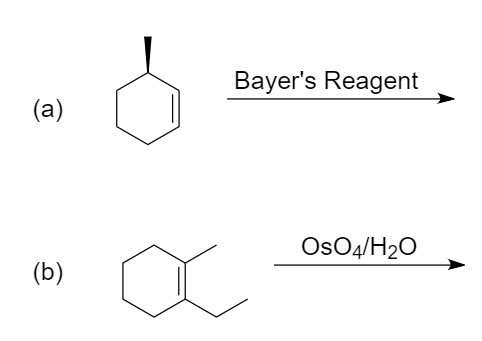
Predict the major products for the given reactions:


Answer
426.6k+ views
1 likes
Hint: In the presence of Bayer’s reagent and osmium tetroxide, the oxidation of alkene takes place and vicinal diol i.e., a compound having OH group at two adjacent carbon atoms, is formed. These reactions are categorized under the addition reaction of alkenes.
Complete answer:
(a) Bayer’s reagent: It is an alkaline solution of cold and dilute potassium permanganate i.e.,
The mechanism followed for given reaction conditions is as follows:
Step-1: Dissociation of
Step-2: Attack of

Step-3: On hydrolysis, the cyclic intermediate converts into vicinal diol.

Hence, the major product that is formed after the reaction is
(b) Osmium tetroxide: Its molecular formula is
The mechanism followed for given reaction conditions is as follows:
Step-1: The

Step-2: The cyclic intermediate form will undergo hydrolysis to yield a vicinal diol.

Hence, the major product that is formed after the reaction is
Note:
It is important to note that the product formed in both the cases will be the syn product i.e., both the hydroxyl group attached to the carbon atoms will be in the same plane which can be either above the plane or below the plane with respect to the plane in which the substituted groups are present.
Complete answer:
(a) Bayer’s reagent: It is an alkaline solution of cold and dilute potassium permanganate i.e.,
The mechanism followed for given reaction conditions is as follows:
Step-1: Dissociation of
Step-2: Attack of

Step-3: On hydrolysis, the cyclic intermediate converts into vicinal diol.

Hence, the major product that is formed after the reaction is
(b) Osmium tetroxide: Its molecular formula is
The mechanism followed for given reaction conditions is as follows:
Step-1: The

Step-2: The cyclic intermediate form will undergo hydrolysis to yield a vicinal diol.

Hence, the major product that is formed after the reaction is
Note:
It is important to note that the product formed in both the cases will be the syn product i.e., both the hydroxyl group attached to the carbon atoms will be in the same plane which can be either above the plane or below the plane with respect to the plane in which the substituted groups are present.
Recently Updated Pages
Master Class 9 General Knowledge: Engaging Questions & Answers for Success

Master Class 9 English: Engaging Questions & Answers for Success

Master Class 9 Science: Engaging Questions & Answers for Success

Master Class 9 Social Science: Engaging Questions & Answers for Success

Master Class 9 Maths: Engaging Questions & Answers for Success

Class 9 Question and Answer - Your Ultimate Solutions Guide

Trending doubts
State and prove Bernoullis theorem class 11 physics CBSE

Who built the Grand Trunk Road AChandragupta Maurya class 11 social science CBSE

1 ton equals to A 100 kg B 1000 kg C 10 kg D 10000 class 11 physics CBSE

State the laws of reflection of light

One Metric ton is equal to kg A 10000 B 1000 C 100 class 11 physics CBSE

Difference Between Prokaryotic Cells and Eukaryotic Cells




